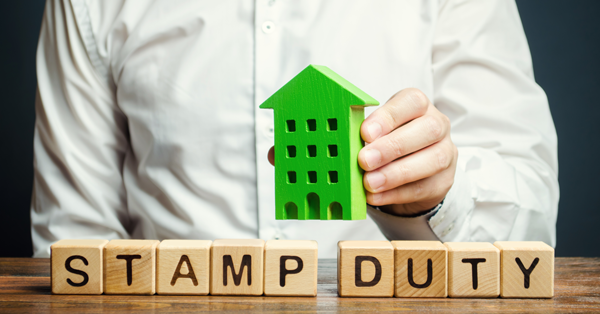Stamp Duty When One is a First-Time Buyer
- The stamp duty land tax (SDLT) system is progressive, meaning that different portions of the property price are taxed at different rates.
- Top tip: Engage with a conveyancing solicitor or property advisor who can guide you through the stamp duty land tax implications.
- As of the latest regulations, first-time buyers are exempt from SDLT on properties valued up to £300,000.
- First-time buyer relief typically applies only to purely residential properties, so mixed-use properties might not qualify.
Buying a home is one of life's most significant milestones, especially for first-time buyers who are stepping onto the property ladder.
The purchasing process involves various financial implications, with Stamp Duty Land Tax (SDLT) being one of them.
We’ll delve into the specifics of SDLT for a first-time buyer, the scenarios involving multiple buyers, and the benefits available when both purchasers are first-time buyers.
What is stamp duty?
Properties bought in the UK are subject to taxes, including stamp duty, charged on homes and land over a certain price. The amount varies depending on the property value and the circumstances of the buyer(s); for first-time buyers, there are specifics surrounding payable stamp duty tax that can significantly impact the overall cost of purchasing a home.
The stamp duty system is progressive, meaning that different portions of the property price are taxed at different rates.
How much stamp duty for a residential property? The current stamp duty rates (as of 2025) are:
- Up to £125,000: 0%
- £125,001 to £250,000: 2%
- £250,001 to £925,000: 5%
- £925,001 to £1.5 million: 10%
- Above £1.5 million: 12%
These rates are subject to change, so it is advisable to check the latest information from HM Revenue and Customs (HMRC).
Stamp duty first-time buyers
First-time buyers in England can benefit from stamp duty relief to make it easier for them to purchase their first home. As of the latest regulations, first-time buyers are exempt from stamp duty on properties valued up to £300,000.
For properties priced between £300,001 and £500,000, stamp duty is payable only on the amount exceeding £300,000, at a rate of 5%. No relief is available for properties over £500,000.
To qualify as a first-time buyer, an individual must meet the following criteria:
- No previous property ownership: The buyer must not have previously owned a freehold or leasehold interest in a residential property anywhere in the world.
- Main residence: The property being purchased must be intended as the buyer’s primary residence.
Example: Imagine Sophie, a first-time buyer, purchases her first home for £280,000. Since the property value is below £300,000, she will pay no stamp duty, saving her a considerable amount of money.
Once a first-time buyer purchases a property, they lose the eligibility for first-time buyer relief on any subsequent property purchases. Future purchases will be subject to pay stamp duty rates.

Multiple buyers: one is a first-time buyer
When purchasing a propertyjointly, the eligibility for SDLT rate relief becomes more complex if only one buyer is a first-time buyer.
The key principle is that all purchasers must qualify as first-time buyers to benefit from the SDLT relief. If one of the buyers has previously owned a property, the entire purchase does not qualify for the first-time buyer relief, and standard SDLT rates will apply.
Example Scenario: John and Sarah are buying a property together for £350,000. John is a first-time buyer, but Sarah has previously owned a home.
Despite John’s status, they are not eligible for first-time buyer relief, and the standard stamp duty rates will be applied to their purchase. This means they will pay stamp duty on the entire purchase price according to the standard rates.
In this scenario, the stamp duty calculation would be:
- 0% on the first £125,000: £0
- 2% on the next £125,000 (up to £250,000): £2,500
- 5% on the remaining £100,000 (from £250,001 to £350,000): £5,000
- Total SDLT payable: £7,500
Use our Stamp Duty Calculator
Multiple buyers: both are first-time buyers
When both people are first-time buyers, they can jointly benefit from the stamp duty relief, provided the property value meets the eligibility criteria. This can result in substantial savings, making the first step onto the property ladder more financially manageable.
Example Scenario: Emily and James, both first-time buyers, purchase a property for £350,000. They will pay 5% SDLT on the £50,000 amount exceeding the £300,000 threshold, resulting in a tax payment of £2,500.
In this scenario, the stamp duty calculation would be:
- 0% on the first £300,000: £0
- 5% on the remaining £50,000: £2,500
- Total SDLT payable: £2,500
This relief offers a significant reduction compared to the standard SDLT rates, which would have amounted to £7,500 for the same property value if neither buyer was a first-time buyer.

Shared Ownership properties
First-time buyers purchasing through shared ownership schemes can also benefit from SDLT relief. Shared ownership allows buyers to purchase a share of the property (typically between 25% and 75%) and pay rent on the remaining share. First-time buyers have two options for SDLT:
- Pay stamp duty land tax on the full market value of the property.
- Pay stamp duty land tax on the purchased share initially and pay any further SDLT upon staircase (buying additional shares) if the total share exceeds 80%.
Example: Lucy buys a 50% share of a property valued at £300,000 through a shared ownership scheme. She decides to pay stamp duty on the full market value, benefiting from the first-time buyer relief and therefore pays no SDLT. She can then buy a bigger share of the property later on without having to pay stamp duty again.
However, if she opted to pay stamp duty on her original 50% share, she would then be liable to pay SDLT on the next share purchase. It's always advisable to pay the tax on the full market value as a first-time buyer as long as it falls below the threshold.
Some developers might offer SDLT relief if you're purchasing a new build home - it's best to check with your local developers to see what sort of incentives they're currently offering. It could be SDLT payments, interior design help, or moving cost assistance.
Looking for a Stamp Duty loophole?
There isn't a "loophole" to avoid paying Stamp Duty, but there are ways you can effectively reduce the amount you pay on a property purchase or a transfer.
Joint Tenants vs Tenants in Common
The ownership structure does not affect SDLT relief eligibility. Whether the property is purchased as joint tenants (where each owns an equal share) or as tenants in common (where ownership shares can differ), the key factor remains whether all parties involved are first-time buyers.
Example: Alex and Maria, both first-time buyers, purchase a property as tenants in common, with Alex owning 60% and Maria 40%. They still qualify for first-time buyer relief if the property meets the price threshold.
This would depend on the full market value of the property, but if it falls below the required threshold for the relief, they pay no SDLT. However, if it is above the threshold, they will need to pay the tax.
However, if Alex is a FTB with 99% ownership, but Maria is not a FTB with 1% ownership, stamp duty tax would be payable.
If Maria is on the mortgage to help Alex afford his first home, they could opt for a joint borrower sole proprietor mortgage to avoid paying SDLT. This way, Maria will share the responsibility of the mortgage, but won't be registered on the legal title of the property.
Mixed-use properties
If a property is classified as mixed-use (part residential and part commercial), it may be subject to different SDLT rules. First-time buyer relief typically applies only to purely residential properties, so mixed-use properties might not qualify.
Example: Rachel buys a property that includes a shop on the ground floor and a flat above it for £500,000. This mixed-use property does not qualify for first-time buyer relief, and she will pay SDLT at the non-residential property rates.

Transferring equity
If a first-time buyer is transferring equity (e.g., adding a partner to the mortgage) and the property’s value exceeds the SDLT threshold, SDLT may be payable based on the value of the equity transferred.
Example: Paul owns a property valued at £400,000 and adds his partner, Clara, to the mortgage. Clara pays Paul £200,000 for her share. As Clara is effectively purchasing half the property, she will pay stamp duty on the £200,000 based on the standard rates since it’s a transfer of equity.
What about a borrower-non-proprietor?
If you need a second buyer to help you buy, but want to avoid the extra SDLT, they can come onto the mortgage with a joint borrower sole proprietor mortgage. The first-time buyer will have 100% ownership, but the borrower non-proprietor has to get independent legal advice.
Practical steps for first-time buyers
Determine Eligibility: Ensure you meet the criteria for first-time buyer relief. Confirm that you have never owned a property before and that the property will be your main residence.
Budgeting for SDLT: Calculate the potential SDLT payable on your prospective property to budget accordingly. Use online SDLT calculators to get an estimate based on current rates and your buying scenario.
Consult with Professionals: Engage with a conveyancing solicitor or property advisor who can guide you through the SDLT implications and help with the completion of all necessary documentation and declarations.
Stay Informed: SDLT rules and rates can change. Keep up to date with the latest information from HMRC or your conveyancer to avoid any surprises.
Consider Government Schemes: Explore other government schemes available to first-time buyers, such as Help to Buy or Shared Ownership, which might further reduce the financial burden.
Jack is our resident Content Writer with a wealth of experience in Marketing, Content, and Film. If you need anything written or proof-read at a rapid speed and high quality, he's your guy.
Caragh is an excellent writer and copy editor of books, news articles and editorials. She has written extensively for SAM for a variety of conveyancing, survey, property law and mortgage-related articles.









